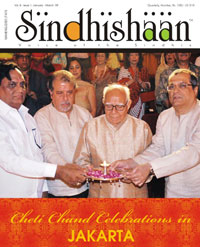HERE ARE TREE REASONS WHY YOU MUST SPEAK SINDHI
By Devendra Kodwani

If Sindhi is your mother tongue, mother language or home language, please read on. I put before you three reasons for speaking and learning Sindhi that you as an intelligent human being should consider before forming any quick judgement based on the title only. But before I do that I call for your patience to read about some events that took place 56 years ago in what was at that time East Pakistan (now Bangladesh).
February 21st is a special day, not because it is exactly one week after Valentine day, but because it is celebrated as International Mother Language Day (IMLD)! If you knew great! if not, you know it now. Why would United Nations educational, scientific and cultural organisations (UNESCO) deem it appropriate at the turn of the second millennium AD to declare a day to celebrate importance and recognition of mother language? Bit of search and lot of curiosity led me to a gripping story of struggle and sacrifice to sustain one's mother tongue. The events leading to IMLD were intimately related to a major unfortunate event of 20th century, namely partition of India which has had direct impact on my and your life as Sindhi.

Division of India was a hurriedly carried out exercise. The demarcation of lines between India and the new nation of Pakistan was such that Pakistan was born on two sides of India! On the east side was East Pakistan (which was carved out of Bengal), where the people did share the religion with the population on the other side of Pakistan but not the language. Bengalis have a rich tradition of literature and great language just as the people speaking Urdu, Punjabi, Sindhi, Pushto and other languages in Pakistan on western side. Soon after independence in 1948, the Pakistani government decided on Urdu as the only official language for Pakistan. The Bengali speaking people of East Pakistan started a resistance to this decision and launched agitations. On 21st February 1952 the Bengali Language Movement in East Pakistan led to unrest in Dhaka and to police firing and many students lost their lives fighting for the recognition of Bengali as one of the official languages of Pakistan. Subsequently in 1956 Bengali was recognised as one of the official languages in Pakistan. A beautiful monument, Shaheed Minar, commemorating the sacrifices of the students for their mother tongue is located on the campus of Dhaka University. Till today 21st February is celebrated as Bengali Language Movement day in Bangladesh. In 1999 the United Nations, based on proposals from Bangladesh and some other language lovers declared 21st February as International Mother Language Day. You must be wondering what has all this got to do with Sindhis living in 21st century world, particularly Hindu Sindhis most of who left Sindh in 1947 and got dispersed in India and many other parts of world. Well, the Bengali language movement shows that language is an integral part of one's identity and very being.
Now, let's talk straight and answer this question which one hears quite frequently talking to young Sindhis in urban India or abroad. What is the use of learning Sindhi language? It is of no use in business and profession, it does not help in education as English dominates school and higher education therefore, there is no need to learn Sindhi. Let's deal with this functional (utilitarian) argument for not learning first which also leads to my first reason for learning Sindhi. It is clear that there is truth in the statement that Sindhi in today's world does not find place in the world of commerce and professions and is neither a medium of instruction at higher education levels. Many other Indian regional languages, and even Hindi, are also facing this challenge, although not as severally as Sindhi. Now consider extending the functional argument to other areas. Let's take architecture. What is the functional utility of having great architecture in present times? Imagine someone arguing that Taj Mahal or Egyptian Pyramids or Stonehenge or Eiffel Tower having no functional utility and hence suggest that they be demolished to construct houses or offices on those spots. Most sane people will disagree with such an argument and put forward the case for preserving ancient architecture as these represent some of the finest achievements of human endeavours. That's why so many of these places are declared as World Heritage sites. There many other arts and crafts which may not have so called 'functional' value in our day to day living but we would still support the idea of preserving them. So what's different when we consider a language? Is it because it is intangible compared to a physical structure? As a matter of fact evolution of a full fledged language is a far more complex and intelligent process than the construction of a monument. The refinement and development in linguistic features such as vocabulary, cultural nuances of language use and grammar spans many generations. Yes language is intangible, but it is not 'invisible'. One can read, write, hear and speak – so three senses involved rather than just the eyes to see. It may not possess the same functional 'utility' in time and space but its importance is as high, if not more, than that of ancient architecture and heritage sites. That's the first reason for us to continue speaking and learning to speak, if we don't. Any Language is undoubtedly a highly developed and rich human achievement and hence it is part of global treasures that should not be lost. Language enabled transmission and storage of knowledge that facilitated the growth of civilisations. Sindhi meets these criteria and therefore, using narrow 'functional' view on language does not seem a rational choice for intelligent people.
My second reason for speaking Sindhi is to get a flavour of how rich it is as a language. This short article is not suitable for describing its richness, but having read the great poets, knowing the versatile vocabulary and grammatically sound structure of the language I can only say its richness can be tasted only when we speak or read it. But let me try to tickle your imagination with few facts. There are nearly 7000 languages in the world with known speakers of which 428 are spoken in India, 18 in the UK and 72 in Pakistan. 516 of the total know languages are endangered. Sindhi is spoken by more than 50 million people (according Encarta, reported on Wikipedia, There were 54.6 million speakers of Sindhi in 2006) which makes it 22nd most popular language in the world according to estimates by Ethnologue. (www.ethnologue.com is part of an international organisation that studies trends in languages) According to Nancy Dorian there are three symptoms of death of language: fewer speakers, fewer domains of use, and structural simplification. While there are many speakers of Sindhi, its domains of usage have shrunk seriously because of non-Sindhi medium of education and migration of Sindhis, dispersal all over India and the globe. An important domain of use of language is home and social-cultural domain. Sindhi like many other languages is facing the challenge of so called modernity, where western culture and western languages, particularly English dominate in India. It does not befit the intelligence of Sindhis to deprive themselves and their future generations of this privilege and human responsibility to run the risk of Sindhi becoming gradually an endangered language.
My third reason for speaking Sindhi is based on the evidence that learning one's mother tongue along with other languages has several advantages. Here are some listed by Jim Cummins of University of Toronto:
Bilingualism has positive effects on children's linguistic and educational development: More than 150 research studies conducted during the past 35 years strongly support what Goethe, the German philosopher, once said: The person who knows only one language does not truly know that language. Research suggests that bilingual children may also develop more flexibility in their thinking as a result of processing information through two different languages.
The level of development of children's mother tongue is a strong predictor of their second language development: When parents and other caregivers (e.g. grandparents) are able to spend time with their children and tell stories or discuss issues with them in a way that develops their mother tongue vocabulary and concepts, children come to school well-prepared to learn the school language and succeed educationally.
Children's cultural and linguistic experience in the home is the foundation of their future learning and we must build on that foundation rather than undermine it.
That was my third reason, knowing Sindhi along with other languages is not going to be a disadvantage for you or your children. On the contrary it seems 'profitable', if I may use the term bit lightly knowing very well the enterprising spirit of Sindhis.
Let's conclude now. The aim of this article has been to reason with the readers that it is worth and necessary to speak and learn Sindhi. It is argued that functional utility of a language should not be the only criterion in accepting or rejecting one's mother language. There is clearly a very rich body of literature, rich Sindhi culture embedded in Sindhi language which is part of finest traditions and human achievements which we have responsibility to pass on to the future generations. And finally we've argued that there is scientific evidence that bilingualism helps children do well in education also. I hope you are persuaded enough to make a start, even if it is small start tomorrow morning on the breakfast table having cereal with milk. Here is the richness for you. There is a word 'Shree' Sindhi/Hindi/Sanskrit (after all they are sister languages!). The word Shree means good and also means goddess of prosperity and agriculture. Latin Ceres comes from 'Shree' and Ceres in Latin means goddess of agriculture and food which is the root of word Cereal that you enjoy in the morning. UNESCO declared 2008 as year of International Languages!


